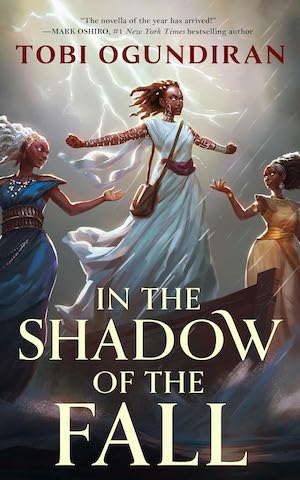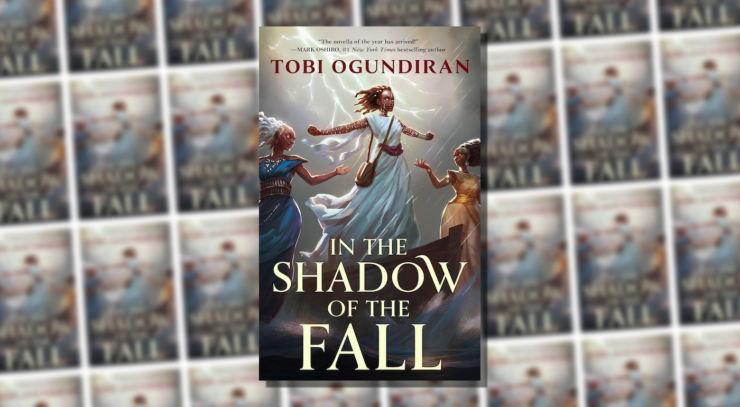Tobi Ogundiran’s novella In the Shadow of the Fall is a coming-of-age story set against a backdrop of warring factions, powerful deities, and unsettling acts of magic. In that way, at least, it’s a familiar outline of a story; we’re not quite in Chosen One territory here, but it doesn’t seem like someone meeting those qualifications might not show up before long.
It’s the story of a young woman named Ashâke, who’s spent many seasons as an acolyte in training, awaiting her induction into the priesthood. As the novella begins, she’s impatient after a lack of contact from the orisha unlike many of her peers, and has set out to bind one of the orisha. The ceremony goes badly, attracting the attention of the temple’s High Priestess and setting Ashâke on a quest of her own in the larger world, where she learns things that shake the very foundations of her worldview.
If you’ve read Ogundiran’s collection Jackal, Jackal—and you should, because it’s a fantastic showcase of Ogundiran’s range as a writer—you’ve read a precursor to this novella, titled “Guardian of the Gods.” In his notes on the story in that book, he explains the idea at the core of that story, one which applies equally well to Ashâke’s journey here:
We mostly live in little bubbles, and the bulk of what we know has largely been externally influenced, from the news to basic tenets of culture, passed down over the centuries. And for the most part we are told things and we take them as truth. But what if the truth you know is not actually truth?
Most of us are not acolytes looking to dedicate our lives to the service of a deity or deities, but there’s something eminently relatable about Ashâke’s situation nonetheless. Part of growing older is the recognition that the authority figures in our lives didn’t necessarily have all the answers, and that certain things they told us were not entirely correct—even if they had their reasons for telling them. In that way, Ashâke’s situation is very relatable.
Buy the Book


In the Shadow of the Fall
That said, in this book’s third chapter, Ogundiran introduces the book’s antagonist, a body-jumping entity known as Yaruddin who serves a mysterious being known only as “The Teacher.” (As a rule of thumb, “The Teacher” is up there with “The Leader” as a sign that the figure in question is probably enmeshed in something sinister.) And, as is often the case in tales of adventure, Ashâke leaves the temple that she has called home behind, venturing into the wider world and discovering uncomfortable truths about the belief system in which she was raised and the larger forces at work in her world.
If the temple where Ashâke was raised is one power in her world and the faction reporting to The Teacher is another, Ogundiran makes it clear relatively early that there are other factions present here as well. Soon, Ashâke falls in with a nomadic band of exiles and griots. As Mama Agba, one of the leaders of the group explains to Ashâke, they operate under different rules than most:
“Half the people in this camp have come to us in some manner or the other. Some were babies abandoned by their parents. Either because they had too many mouths to feed already, or believed the word of some hack shaman who pronounced them cursed. Others were cast from their families, cast from society, shunned and ostracized.”
The griots also share with Ashâke a worldview that offers a very different perspective on the orishas and their history. Over the course of this novella, Ashâke gains more and more information about the true shape of her world and her place in it. It’s a case where several characters she encounters each share with her a piece of a larger puzzle; by book’s end, she has a better sense of what her role in this larger conflict is and who her true adversary is.
In the Shadow of the Fall is the first part of a duology, and it’s not intended as a criticism to say that it feels like the first half of a larger storyline. By the end of the book, Ashâke has discovered some answers to the questions that haunted her in its early pages; her relationship to several other characters has shifted, and she’s discovered new things about herself as well.
If I do have one issue with Ogundiran’s book, it’s that it could stand to be a little more expansive. In his notes to the story “Guardian of the Gods” in Jackal, Jackal, Ogundiran refers to the world he created as one designed to house “a sprawling fantasy of epic proportions.” Now, it’s not clear where Ogundiran is going from here; maybe the second volume will bring Ashâke’s story to a concise ending, or perhaps it’ll set up an even grander conflict to play out in future books. There are plenty of elements here that could be expanded on—the difference in how the temple’s priests perform magic and the abilities of the griots, for instance. In keeping this story focused on Ashâke’s perspective, Ogundiran finds the human scale of an epic story and does so in a way that keeps the narrative moving briskly. But from the glimpses of the world we get here, it certainly seems like there’s room for many more stories to be told here.
As problems go, that’s a pretty good one to have. Ultimately, In the Shadow of the Fall is an immersive, absorbing story written in a way that’s both aware of reader expectations and willing to subvert them when necessary. At its best, it’s the story of a reluctant hero seeking to understand herself better—and learning shocking truths about the true nature of her world as her quest continues.
In the Shadow of the Fall is available from Tordotcom Publishing.
Read an excerpt.










